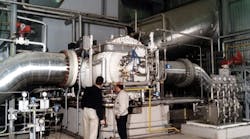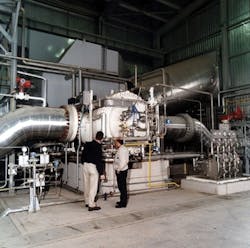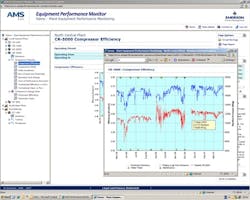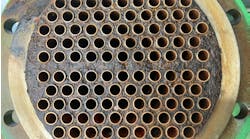As aging process and mechanical equipment begins to deteriorate, its energy effectiveness decreases, power consumption rises, efficiency drops and operating costs escalate. Many of the effects of degradation are avoidable, so being able to identify struggling equipment at an early stage is essential to renewing its productivity — adding dollars to your bottom line. That’s why it’s so important to be aware of the performance of crucial equipment, including key compressors, heat exchangers, steam boilers, turbines and pumps.
Most chemical makers accept an overall loss of efficiency as largely inevitable, part of running a large complicated process. They try to maintain output by pushing the machinery harder and using preventive maintenance and periodic shutdowns. However, preventive maintenance isn’t the answer to avoiding serious problems with your most critical machinery.
Truth is this drop in efficiency stems from small losses throughout the process that can be corrected only when properly identified. The big utility companies, for example, are constantly making strategic efficiency calculations to know where losses are occurring so that a maximum amount of power can be generated for the cost. A similar opportunity now exists for chemical companies to obtain information on current efficiencies of critical equipment that may not be easy to assess — and to achieve true predictive maintenance, which is considerably more cost-effective than schedule-based preventive maintenance.
Advances in equipment performance-monitoring technology coupled with third-party expertise can provide specific details about performance losses of essential machinery along with recommendations for raising the performance of that equipment to acceptable levels. The results can be impressive, for example:
- Detection of a significant efficiency loss of a single critical compressor enabled one company to take corrective action that resulted in a financial benefit of $3 million per year.
- Avoiding an unplanned shutdown saved another company $2.6 million.
- Modifying operation within a heat exchanger network reduced power consumption by 2% without a change in outlet temperatures.
Achieving such results doesn’t require managers to look through a lot of data.
Instead, specialists at the third-party keep them informed and advise about alternatives for any evolving situation that could impact productivity. Performance monitoring gives the managers the hard facts and financial justification to make decisions that affect the entire plant and allow equipment to be optimized for extended run times and maximum productivity. This leads to improved maintenance cycles with lower costs, fault detection and rectification, process improvements identified through performance behavior trends, and greater productivity. Performance deficiencies are minimized, energy costs are reduced, production is maximized, and payback is assured.
Leveraging existing data
Plant equipment produces lots of raw data that reflect its performance — data that could reveal efficiency losses. The problem is that most plant personnel don’t have the time or expertise to do the necessary engineering calculations to determine whether a pump is delivering the intended fluid volume at full throttle or if a boiler is generating a certain amount of steam and, if not, why not. Staff members have other legitimate concerns but eventually the declining performance of some piece of critical equipment will grab their attention. By that time, thousands — even millions — of dollars may have been wasted.
Minimizing such performance degradation and its resultant costs requires a structured performance-monitoring approach based on thermodynamic models that go beyond the calculations many plants already use to simply generate performance data.
Thermodynamic-based performance models cover the expected operating envelope of the equipment of interest as well as overlaying predictions onto the actual plant data to provide a means of confirming the model’s fidelity. In this way, you can continuously and accurately check the condition of your most important assets.
Compressors, boilers and steam or gas turbines are most commonly addressed but a thermodynamic model can be computed on any piece of equipment subject to changes in temperature, pressure and flow. Then, data commonly produced to meet a plant’s environmental, health and safety requirements are compared to the customized model for a picture of how well that machine is actually performing — to determine efficiency loss versus like-new or best case operation. While end-users may be aware that the performance of a piece of equipment is below normal, the extent of the loss can be a shock, and they rarely know what’s causing the degradation.
The most important element of this performance monitoring package is the expertise required to build the thermodynamic model and then distill and validate the large amount of production data from critical pieces of plant equipment. Most plants lack such capabilities and so rely on a third party that has performance specialists. By using the model to analyze this information and formulate actionable recommendations, these experts are able to obtain information about lagging performance that’s never before been available.
For example, using the thermodynamic model of a multi-stage compressor (Figure 1), specialists can determine the current performance of the overall compressor, on each stage of the compressor and, if there are inter-stage coolers, the performance of those coolers as well. In addition, they can define the negative impact of each one of those different sections of the compressor on the machine’s overall performance and show what it’s costing to drive the compressor or how the compressor’s throughput has been reduced (Figure 2).
Figure 1. Fouling due to the rapid build up of deposits of gas and air causes compressor performance to suffer.
Figure 2. Software calculates compressor performance, providing insights for when maintenance should be scheduled. (click to enlarge)
Analysis based on thermodynamic modeling also enables the experts to predict with reasonable accuracy when a piece of equipment should be overhauled. A machine’s history of degradation offers insights on when the efficiency of that unit will drop below a certain level, signaling when it should be taken out of service. This knowledge allows maintenance planners to schedule downtime at the least disruptive time.
Because the raw data come from the regular documentation of ongoing operations, no special measurement equipment is needed on-site. Information can be taken from a data historian or even operators’ log sheets and communicated via the Internet; the actual monitoring and subsequent calculations are done remotely. In most cases, chemical makers create a special script so that performance data on selected machines are automatically communicated via periodic e-mail transmissions from anywhere in the world.
After the data are processed through the sophisticated model, analysts who are intimately familiar with each type of machinery evaluate the feedback and provide a full diagnostic report along with actionable recommendations via a secure web interface, so the end-user can access the information anywhere in the world. For example, a compressor in a plant in China might be monitored, the information processed and analyzed in the U.K., and the results sent to corporate engineers in Houston.
Plenty of possibilities
Chemical plants abound with opportunities for performance monitoring. For example, compressors, including air compressors and those that are integral to refrigeration systems where a process fluid must be maintained at a specific temperature, are frequently critical to production. However, multi-stage compressors are complex machines, making it hard for plant staff to spot degraded performance, let alone determine the source of the problem. A poorly performing multi-stage compressor can cost its operator hundreds of dollars per day in decreased production. Immediate action, possible only when the performance of the machine is being continuously monitored, may well be needed to prevent extended losses.
Temperature measurement plays a key role in the control of compression trains. Accurate readings directly impact the volume of gas compressed and flowing from the machine; that kind of information also can serve as a performance indicator. Using a thermodynamic model to characterize the performance of such a machine, the monitoring software can distinguish between performance deviations and instrumentation drift for all sections of the compressor train, allowing for a true evaluation of the performance of each section. Early identification of instrument error can also reduce production losses.
By using historical data to establish baseline performance for a given machine and checking that against a thermodynamic model of that type of equipment, it’s possible to get an accurate picture of lagging performance. For example, comparing production data on a centrifugal compressor train with manufacturer’s design data showed that a company was losing $800 per hour. Analysis not only revealed the bottleneck compressor but pinpointed the cause to be a faulty recycle valve, which was repaired with minimal downtime. Throughput was immediately boosted by 10%.
In another case, performance monitoring identified a rod drop on a reciprocating compressor. Such a fault could have gone unnoticed and might have caused a catastrophic failure of that equipment.
Likewise, the operational history developed via performance monitoring pinpointed when a stream turbine needed to be cleaned and led to an optimal washing plan. The approach also identified degraded performance of a boiler. It even showed the section of the boiler where the loss was occurring, the severity of the problem and what needed to be done to correct it.
These are areas where plant personnel, in all likelihood, wouldn’t recognize the existence of problems without assistance.
Take the challenge
Ask yourself four questions:
- Are your most critical pieces of equipment delivering optimal performance?
- If not, do you know how much the degraded performance (lost efficiency) is costing in excess energy demand or lower productivity?
- Can you calculate the losses?
- Do you know how to prevent them?
If most of your answers are “no,” performance monitoring may well be cost-effective for you.
One way to find out is to apply the thermodynamic-model-based technology to one critical asset in your plant for six-to-12 months via a straight service contract. This requires no capital expenditures and minimal staff involvement. (Typically, the cost of developing a thermodynamic model and monitoring is the same per piece of equipment, whether a steam boiler, heat exchanger, compressor or motor-pump train.)
You’ll undoubtedly get a clearer understanding of performance losses and the causes of degradation in that equipment. The resulting knowledge and actionable recommendations can be expected to yield improved performance, leading to gains in throughput, lower energy costs or both. Monitoring typically delivers a fast return on investment.
Todd Anderson is a business development manager for Emerson Process Management, based in Chicago. E-mail him at [email protected].




